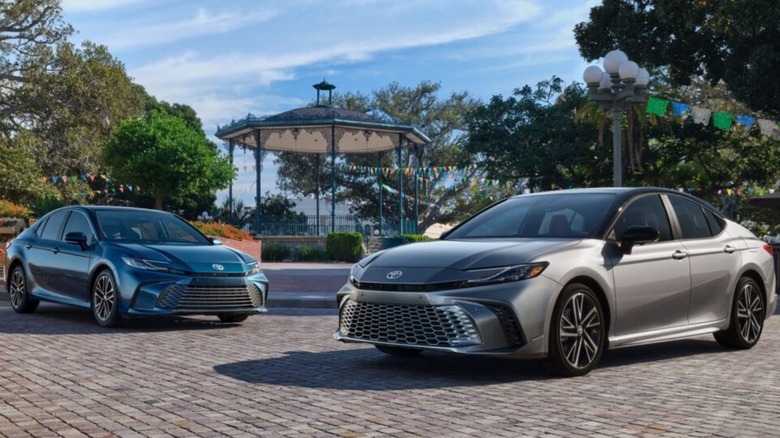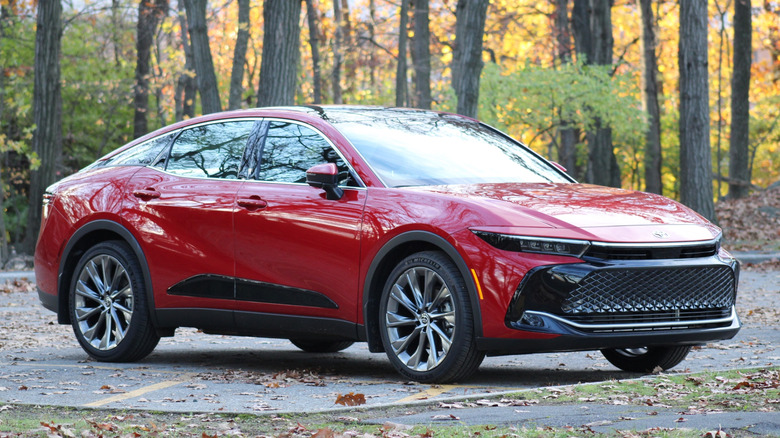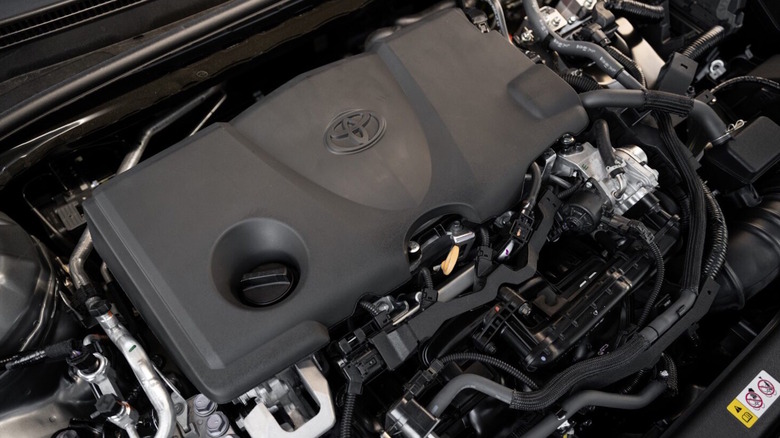Is The Toyota Crown Bigger Than The Camry & In What Other Ways Are They Different?
A look at Toyota's newest offerings shows that sedans are still alive and well. In fact, the Camry remains the best-selling passenger vehicle in America that's not an SUV, with over 300,000 examples sold last year. However, the stalwart Camry isn't Toyota's only sedan. Buyers looking for something with the same or greater capabilities will want to consider the Crown, a sedan that assumed flagship status when it replaced the canceled Toyota Avalon for the 2023 model year.
Interestingly, the Toyota Crown and Camry have some features in common, such as being classified by the U.S. Environmental Protection Agency as mid-size vehicles based on passenger and cargo volume. They also share the Toyota New Global Architecture platform, which underpins several other cars, including the Highlander, the Sienna, and the Lexus ES. With the 2025 model year, the Crown and Camry also shared modified versions of the same hybrid powerplant, alongside interior features like a 12.3-inch infotainment touchscreen supporting Apple CarPlay and Android Auto.
While there is plenty that these car share, there are important considerations that set them apart that may not be apparent at first glance. For instance, all Crown trims except the base have an 11-speaker JBL sound system, but the same sound system requires an upgrade only available for upper trim Camrys. Let's expand these comparisons by examining all the ways that the 2025 editions of the Toyota Crown and Toyota Camry stack up against each other. For the record, the Toyota Crown Signia is a crossover and not part of this evaluation.
How big Is the Toyota Crown compared to the Camry?
Despite having matching EPA size classifications, the Toyota Crown is longer than the Camry on the outside. With a bumper-to-bumper length of 196.1 inches, the Crown outstretches the Camry's 193.5-inch overall length. At the same time, the Crown sits taller at 60.6 inches versus 56.9 inches for the Camry. In addition, the Crown's 112.2-inch wheelbase is one inch longer than the Camry's. A ground clearance of 5.8 inches gives the Crown additional bragging rights over the Camry, which is 0.4 inches lower to the ground. Both models have matching widths of 72.4 inches.
The Crown's larger exterior doesn't always translate into a more spacious cabin. Both vehicles have the same legroom in the front at 42.1 inches. The Crown's 38.9 inches in the second row eke out an extra 0.9 inches over the Camry, but the coin flips in the Camry's favor on other measurements. The Camry has more shoulder room — 57.7 inches in the front and 55.7 in the back, while the Crown is 0.6 inches smaller in both. Hip room is nearly identical in the front, with the Camry at 55.4 inches versus 55.2 for the Crown. The gap is more significant in the back, with 54.6 inches of hip room for the Camry versus 53.1 inches for the Crown.
The Crown's premier size and status in Toyota's lineup alongside higher quality standard features equates to a higher price tag. The least expensive edition starts at $41,440 and rises to $45,960 for the mid-grade Limited. A fully loaded Platinum is just under $55,000. The cheapest Camry starts at $28,700. A FWD-based Camry XLE sells for $33,700, and the XSE rises to $34,900. Check all the boxes and the XSE's price rises north of $44,000.
Crown vs. Camry: Powertrains, performance, fuel economy, and safety tech
Both models are hybrid-only sedans — the Camry joined the electrified club with its 2025 redesign, while the Crown has been a hybrid ever since its 2023 relaunch in the U.S. Both models have Toyota's venerable 2.5-liter four-cylinder hybrid engine under their respective hoods, but there are differences. For instance, the more powerful Hybrid Max system in the Crown Platinum has a 2.4-liter displacement.
In most Crown trims, this powerplant produces a combined 236 horsepower, but upgrading to the top-dog Platinum edition adds a turbocharger, cranking up output to 340 horsepower. Zero to 60 mph performance ranges from 7.6 seconds for the base setup to 5.7 seconds for the Crown Platinum with the Hybrid Max engine. Combined fuel economy ratings are 41 mpg for the standard engine and 30 mpg for the upgrade. The Crown is only offered in all-wheel-drive.
In front-wheel-drive form, the Camry's hybrid system produces 225 net horsepower, increasing to 232 ponies with optional AWD. During the dashes to 60 mpg, MotorTrend reported near identical results – 7.0 seconds for a FWD-equipped Camry and 6.9 seconds for one with AWD. The Camry's combined fuel economy ratings vary by trim but range from 47 to 51 combined mpg for FWD and 44 to 50 mpg for AWD. Lower curb weights can explain the Camry's better acceleration and efficiency numbers — 3,450 to 3,682 pounds versus 3,980 to 4,343 pounds for the Crown.
Inside the top-tier Crown Platinum, you'll find has all the bells and whistles buyers expect in a modern flagship. Advanced driver assistance systems like front cross-traffic alert, semi-autonomous parking, and lane change assist. Adding these amenities to the Camry requires opting for the more expensive XLE or XSE trim and adding an option package or two.


